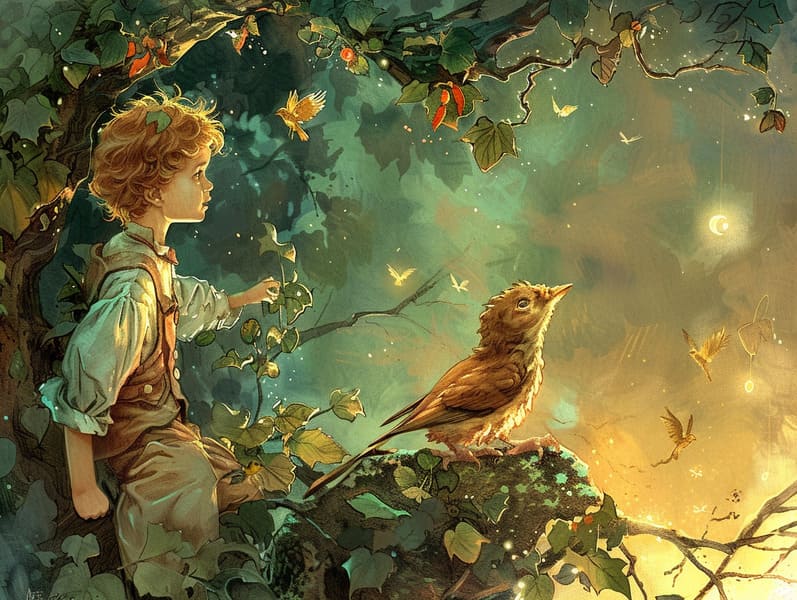
Classic fairy tales have historical significance. These stories have been recounted from one generation to the next centuries before they were ever recorded. They developed from a variety of backgrounds, including American traditions. They were initially narrated among elders, often carrying themes and messages mirroring the societal norms and beliefs of the time.
The Grimm brothers, Jacob and Wilhelm, were among the first to gather and publish many of these beloved tales. Their published works, "Grimm's Folk Tales," included tales like "Cinder Maid," "Little Brother and Little Sister," and "Little Snow White," which have since become classics in the world of beloved fairy tales. Similarly, Andersen's whimsical stories, such as "The Story of the Little Mermaid," and "The Duckling's Story," have touched hearts worldwide, cementing their place in the pantheon of timeless fairy tales.
Though they are centuries old, these tales remain as applicable as ever, especially as children's bedtime stories. These fantastical tales are now available in many formats, including richly illustrated books, charming animations, and online storybooks.
Their lasting presence can be credited to several whimsical characteristics:
Valuable Lessons: Classic fairy tales often share important moral lessons. Fairy tales like "The Wolf and the Liar" teach the benefit of being truthful, while "The Tale of the Tortoise and the Hare" illustrate the values of persistence and meekness. These narratives offer young ones clear distinctions between ethical and unethical, forming their moral compass in a soft yet profound way.
Warmth and Understanding: Timeless fairy tales frequently feature characters facing problems and hurdles, urging readers to understand with their struggles and rally behind their triumphs. For instance, "Beauty and the Beast" reveals the merit of looking beyond appearances to appreciate the inner self of a soul, nurturing sympathy and understanding.
Cultural Perception: Many old fairy tales are imbued with the cultural contexts from which they grew. Understanding these narratives can provide informative snapshots into different social structures, developing a sense of global appreciation and knowledge.
Inventiveness and Imagination: The mythical elements in timeless fairy tales—magical spells—generate children’s visions and dreams. These fairy tales move readers to mythical realms, boosting creative thinking and a sense of wonder that stays a lifetime.
Ancient fairy tales are not only magical but also didactic. They serve as entrancing tools in advancing various mind and heart abilities in children. When ancient fairy tales are told out loud, they boost communication skills by teaching new phrases and complex sentence structures. This practice also fosters auditory skills and attentiveness, as the young concentrate deeply, expectant to see what happens next.
Furthermore, discussing the themes and characters of traditional fairy tales can cultivate problem-solving abilities and reasoning skills. Young ones are educated to pinpoint patterns, make predictions, and realize cause and effect. These talks also facilitate kids speak out their thoughts and feelings, enhancing their emotional intelligence.
In today’s information age, the abundance of online storybooks has made these stories more within reach than ever. Online platforms and apps share extensive collections of famous fairy tales that can be looked at or listened on anytime, anywhere. Fairy tales read aloud are particularly prevalent, presenting an immersive method for young readers to enjoy these alluring stories. Audio stories and read-out-loud videos transport characters find it here and settings to life, often complemented by mesmerizing harmonies and background music that elevate the storytelling experience.
The timeless fascination of traditional fairy tales lies in their ability to shift to current times while retaining their essential themes. Contemporary revisions of these stories often introduce more multicultural protagonists and modern settings, making them pertinent to today’s audience. However, the central morals of valor, charity, and equity remain unchanged, continuing to connect with children of all ages.
Fairy tales also offer a sense of security and knownness. They present a coherent narrative with a plain beginning, middle, and end, often winding up with the resolution of conflicts and the triumph of right over wrong. This dependability can be placating for little ones, bringing a sense of solidity in an fluctuating world.
Timeless fairy tales continue to enchant and educate new generations, maintaining their majesty and relevance in modern society. As bedtime stories for kids, they afford a perfect blend of charm and enlightenment, furthering moral values, empathy, and creativity. The presence of online fairy tales and the widespread nature of fairy tales read aloud affirm that these classic narratives remain attainable to new generations.
By sustaining and conveying these tales, we continue to treasure the rich tapestry of mythology and cultural heritage. Whether you are accessing a colorful picture book, browsing a web collection, or listening via an sound book, the charm of children's fairy tales is always within reach. These fairy tales show us of the enduring ability of narratives and its ability to tie us across eras and regions.
No matter if you are experiencing a beautifully illustrated book, enjoying a online collection, or listening via an read-aloud story, the majesty of traditional fairy tales is always within reach.
These narratives reveal of the undying nature of stories and its ability to tie us across eras and regions, creating a bond that fascinates and enlightens alike.